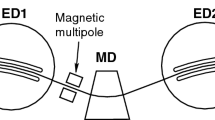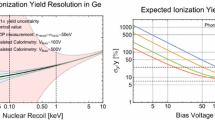Abstract
SuperCDMS is a direct detection search for WIMPs, currently operating a 9 kg array of germanium detectors in the Soudan Underground Laboratory. The detectors, known as iZIPs, are cylindrical in shape and each flat surface is instrumented with both ionization and phonon sensors. Charge and phonon information is collected for each event, and comparing the energy collected in the phonon sensors to the charge sensors gives excellent discrimination power between nuclear recoil and electron recoil events. Furthermore, this technology provides excellent discrimination between surface and bulk events. In order to show the surface event rejection capability of these detectors, two \(^{210}\)Pb sources were installed facing two of the detectors currently operating in the Soudan experimental run. The \(^{210}\)Pb decays to \(^{210}\)Bi, which in turn decays to \(^{210}\)Po. The \(^{210}\)Po decays by alpha emission, yielding a recoiling \(^{206}\)Pb ion with 103 keV kinetic energy and an alpha particle with 5.4 MeV kinetic energy. We used the non-standard Screened Nuclear Recoil Physics List (Mendenhall and Weller, Nucl. Instrum. Methods Phys. Res. B 227:420–430, 2005) in Geant4 (Agostinelli et al., Nucl. Instrum. Methods Phys. Res. Sect. A 506:250–303, 2003) to simulate all of the above decays and achieve excellent agreement with experiment. The focus of this paper is the simulation of the \(^{210}\)Po decay.





Similar content being viewed by others
References
M.H. Mendenhall, R.A. Weller, Nucl. Instrum. Methods Phys. Res. B 227, 420–430 (2005)
S. Agostinelli et al., Nucl. Instrum. Methods Phys. Res. Sect. A 506, 250–303 (2003)
Agnese et al.: Submitted to, Physical Review Letters, arXiv:1305.2405, (2013).
I. Lazanu, M.L. Ciurea, S. Lazanu, Astropart. Phys. 44, 9–14 (2013)
J.F. Ziegler, M.D. Ziegler, J.P. Biersack, Nucl. Instrum. Methods Phys. Res. Sect. B 268(11–12), 1818–1823 (2010)
Acknowledgments
The SuperCDMS collaboration gratefully acknowledges the technical assistance from Jim Beaty and the staff of the Soudan Underground Laboratory and the Minnesota Department of Natural Resources. These iZIP detectors are fabricated in the Stanford Nanofabrication Facility which is a member of the National Nanofabrication Infrastructure Network sponsored by NSF under Grant ECS-0335765. This work is supported in part by the National Science Foundation, by the Department of Energy, by NSERC Canada, and by MULTIDARK CSD2009-00064 and FPA2012-34694. Fermilab is operated by Fermi Research Alliance, LLC under Contract No. De-AC02-07CH11359, while SLAC is operated under Contract No. DE-AC02-76SF00515 with the United States Department of Energy.
Author information
Authors and Affiliations
Corresponding author
Additional information
For SuperCDMS Collaboration.




